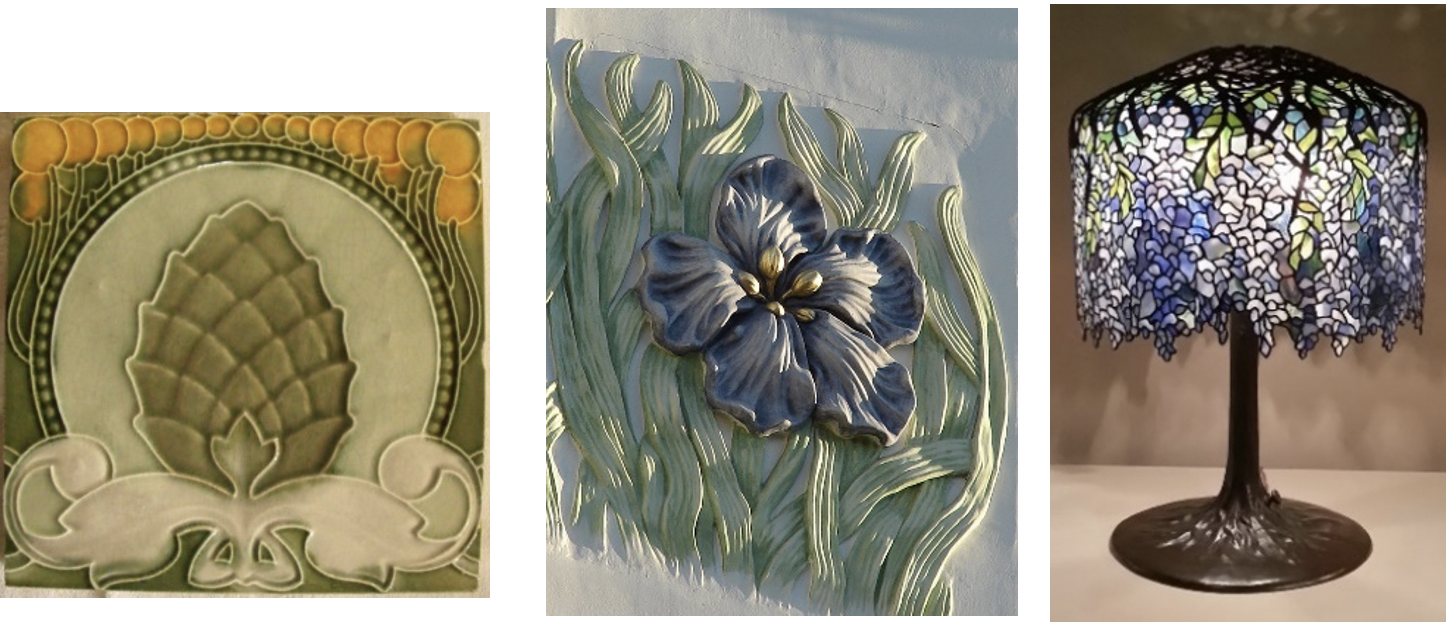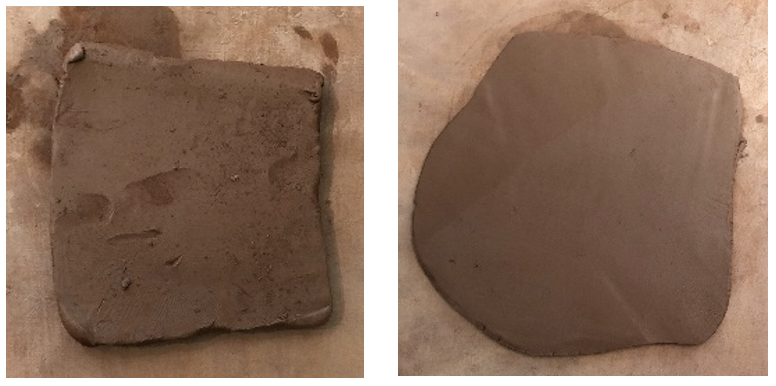Students will observe Art Nouveau style art then create a create a clay tile with a flower motif, inspired by this style. Recommended for 3rd Graders.
Line: a mark on a surface between two points.
Shape: an enclosed line, having height and width, lacking depth. It is either geometric, with angles/corners or organic, as found in nature, without angles/corners.
Texture: actual texture is how something feels when touched; visual texture (also called simulated texture) is how something appears to feel.
Emphasis (focal point): the part of an artwork that is emphasized in some way and attracts the eye and attention of the viewer; also called the center of interest or focal point.
Bas Relief: (pronounced "bah ree·leef") is a sculpture technique in which design elements stick out from the surface, creating a bumpy texture.
Clay: A fine-grained, firm material that is plastic (sculpt-able) when wet and hardens under extreme heat, consisting primarily of water, silica (glass) and finely grained rock. It is widely used in making bricks, tiles, and pottery.
Curvilinear: made of curved lines.
Firing: the act of heating dried clay to a specific temperature to permanently harden it.
Glazes: a mixture of clay, water, colorants and silica. When fired it becomes colorful, hard and glassy.
Scoring (Scratch & Attach): how we attach two wet clay pieces, by scratching each touching clay surface to ‘interlock them’ before pressing together firmly.Slip: the slurry clay/mixture the consistency of melted ice cream. Used to attach wet clay pieces.
Clay Building:
Art Nouveau was an international art style very popular at the turn of the 20th century (1890 – 1910). It incorporated curvy forms, a decorative approach and was often inspired by the natural forms of plants. A major tenant of Art Nouveau was to blur the lines between “fine” art and applied art (architecture, furniture design, interior design and graphic design). Lots of household comforts would have art nouveau touches: pillows, furniture, tile work, wood working, jewelry and fabrics. This style used many mediums not typically used in “fine” art like: glass, metal, wood, ceramics and textiles. Louis Tiffany’s lamps, Antoni Gaudi’s architecture and Alphonse Mucha’s graphic arts posters are great examples of the Art Nouveau style.

Above left image from Au Fil de l'Eau Antiques website. Above right image Louis Tiffany lamp.
This lesson requires two sessions.

Post vocabulary and briefly go through it. Use vocabulary throughout lessons.
Show images (2 or 3) of Art Nouveau pieces of other household items, in addition to what’s in the lesson.
What kind of things are these? - decorative, usable household items
Students will:
• Observe Art Nouveau style art
• Create a clay tile inspired by this style.
• Use clay tools and techniques.
• Use art vocabulary.
• Use good craftsmanship.
Set up the work space with taped butcher paper or canvas mats on the tables to work on. Put out the slip or water in small plastic tubs or bowls, not much (you can always refill).
Building tools: Every students space should have a slab, scrap clay, a plastic knife, a pencil and a skewer.



Volunteer:
- The little bits of clay can be brushed off before you put them in the kiln, when they are dry. If students do it now it will smear their lines.
- Make sure to dry these pieces flat on newsprint so that they can shrink freely.
Instructions for Glazing the Tile
Lesson from Newcastle Elementary. More about Bas Relief can be found here: https://www.thoughtco.com/bas-relief-183192; see also https://commons.wikimedia.org/w/index.php?curid=28011259.
21st Century Thinking Skills
Thinking flexibly, persisting, questioning, creating, innovating, listening with empathy, taking responsible risks, observing, making connections, visualizing, sequencing, predicting, comparing/contrasting, determining main idea, finding evidence, problem solving, cause and effect, determining point of view, decision making.
WA State Learning Standards
(VA:Cr1.1.3) a. Elaborate on an imaginative idea.
(VA:Cr1.2.3) a. Apply knowledge of available resources, tools, and technologies to investigate personal ideas through the artmaking process.
(VA:Cr2.1.3) a. Create personally satisfying artwork, using a variety of artistic processes and materials.
(VA:Cr2.2.3) a. Demonstrate an understanding of the safe and proficient use of materials, tools, and equipment for a variety of artistic processes.
(VA:Cr3.1.3) a. Elaborate visual information by adding details in an artwork to enhance emerging meaning.
(VA:Pr6.1.3) a. Identify and explain how and where different cultures record and illustrate stories and history of life through art.
(VA:Re7.1.3) a. Speculate about processes an artist uses to create a work of art.
(VA:Re9.1.3) a. Evaluate an artwork based on given criteria.
(VA:Cn10.1.3) a. Develop a work of art based on observations of surroundings.
(VA:Cn11.1.3) a. Recognize that responses to art change depending on knowledge of the time and place in which it was made.
Please note: These lesson plans are intended for non-profit use only. Use of these plans for commercial purposes should give attribution to the Issaquah Schools Foundation and be accompanied by a nominal donation at www.isfdn.org/donate. Thank you.
Fueling Success for Every Student, Every School